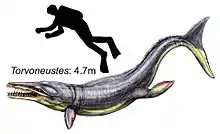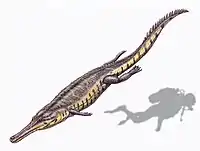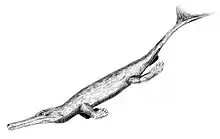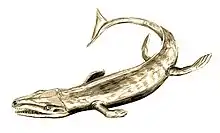Torvoneustes
Torvoneustes is an extinct genus of metriorhynchid thalattosuchian. It is known from skull and postcranial remains found in the Kimmeridge Clay Formation of Dorset and Wiltshire, England, and also from Oaxaca, Mexico[2][3] . The holotype skull of the type species was initially assigned to the species Metriorhynchus superciliosus. Postcranial remains were later discovered from the same quarry as the skull, and then these specimens were recognised as belonging to a new species of Dakosaurus, as D. carpenteri. The species was named to honour Simon Carpenter, an amateur geologist from Frome in Somerset, who discovered the fossils.[4][5]
| Torvoneustes | |
|---|---|
 | |
| Size of T. carpenteri | |
| Scientific classification | |
| Kingdom: | Animalia |
| Phylum: | Chordata |
| Class: | Reptilia |
| Suborder: | †Thalattosuchia |
| Family: | †Metriorhynchidae |
| Tribe: | †Geosaurini |
| Genus: | †Torvoneustes Andrade et al., 2010 |
| Type species | |
| †Dakosaurus carpenteri Wilkinson et al., 2008 | |
| Species[1][2] | |
| |
| Synonyms | |
| |
Dakosaurus carpenteri was later reassigned to the genus Geosaurus in 2008. Two years later, it was assigned to its own genus, Torvoneustes.[6]
When T. carpenteri was considered a species of Dakosaurus, its relatively long snout and smaller, more numerous teeth were thought to be features retained from more basal metriorhynchids. Because of this, the species was seen as a transitional form between long-snouted, piscivorous metriorhynchids and hypercarnivorous, short-snouted species of Dakosaurus.[4]
While Dakosaurus and Geosaurus have ziphodont dentition with teeth that are laterally compressed, Torvoneustes is unique in having a false-ziphodont dentition. The common ancestor of Dakosaurus and Geosaurus may also have had a ziphodont dentition, and as Torvoneustes is also a descendant of this common ancestor, it is possible that a ziphodont dentition was secondarily lost in the genus. However, it is also possible that Dakosaurus and Geosaurus acquired similar dentitions independently, and that Torvoneustes is not descended from a ziphodont ancestor.[6]
References
- Young, M. T.; Andrade, M. B.; Etches, S.; Beatty, B. L. (2013). "A new metriorhynchid crocodylomorph from the Lower Kimmeridge Clay Formation (Late Jurassic) of England, with implications for the evolution of dermatocranium ornamentation in Geosaurini". Zoological Journal of the Linnean Society. 169 (4): 820. doi:10.1111/zoj.12082.
- Jair I. Barrientos-Lara; Yanina Herrera; Marta S. Fernández; Jesús Alvarado-Ortega (2016). "Occurrence of Torvoneustes (Crocodylomorpha, Metriorhynchidae) in marine Jurassic deposits of Oaxaca, Mexico". Revista Brasileira de Paleontologia. 19 (3): 415–424. doi:10.4072/rbp.2016.3.07.
- Mark T. Young; Davide Foffa; Lorna Steel; Steve Eches (2019). "Macroevolutionary trends in the genus Torvoneustes (Crocodylomorpha, Metriorhynchidae) and discovery of a giant specimen from the Late Jurassic of Kimmeridge, UK". Zoological Journal of the Linnean Society. x (x): xx. doi:10.1093/zoolinnean/zlz101.
- Wilkinson, L.E.; Young, M.T.; Benton, M.J. (2008). "A new metriorhynchid crocodilian (Mesoeucrocodylia: Thalattosuchia) from the Kimmeridgian (Upper Jurassic) of Wiltshire, UK". Palaeontology. 51 (6): 1307–1333. doi:10.1111/j.1475-4983.2008.00818.x.
- "Amateur geologist's Jurassic discoveries go on display", from the Evening Post, Thursday, February 12, 2009, 15:45
- Andrade, M.B.D.; Young, M.T.; Desojo, J.B.; Brusatte, S.L. (2010). "The evolution of extreme hypercarnivory in Metriorhynchidae (Mesoeucrocodylia: Thalattosuchia) based on evidence from microscopic denticle morphology". Journal of Vertebrate Paleontology. 30 (5): 1451–1465. doi:10.1080/02724634.2010.501442.



